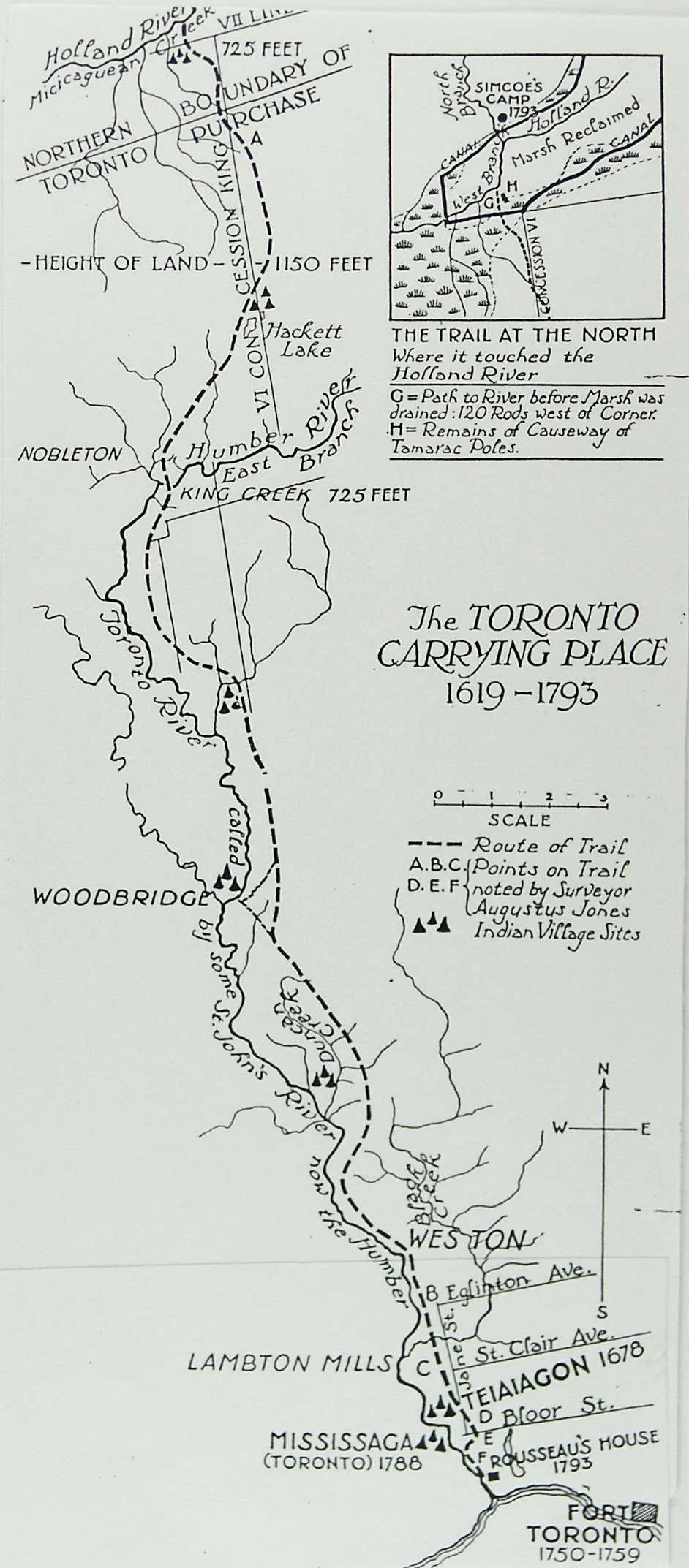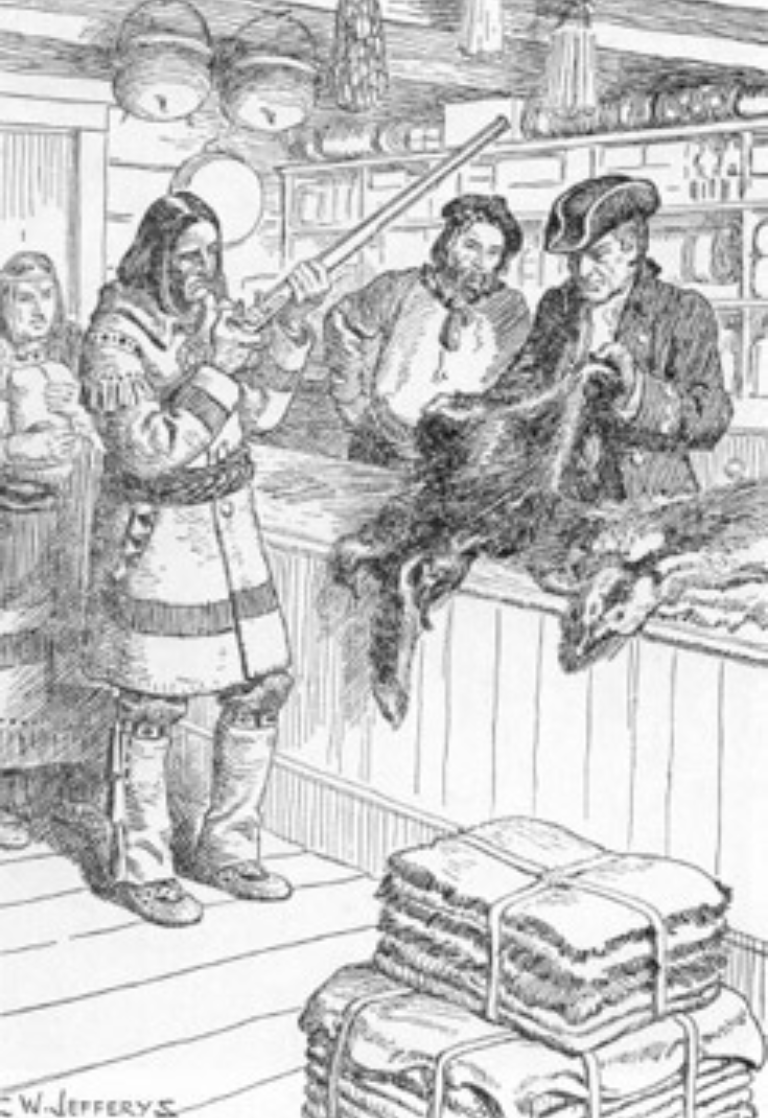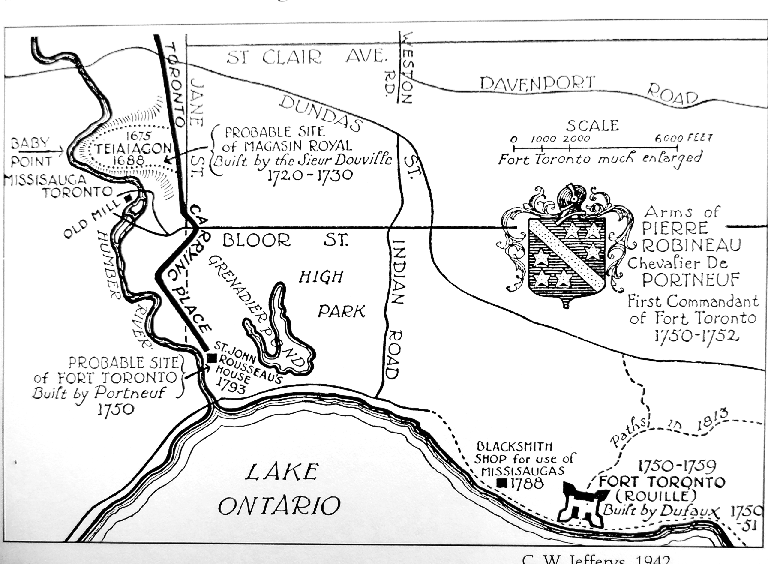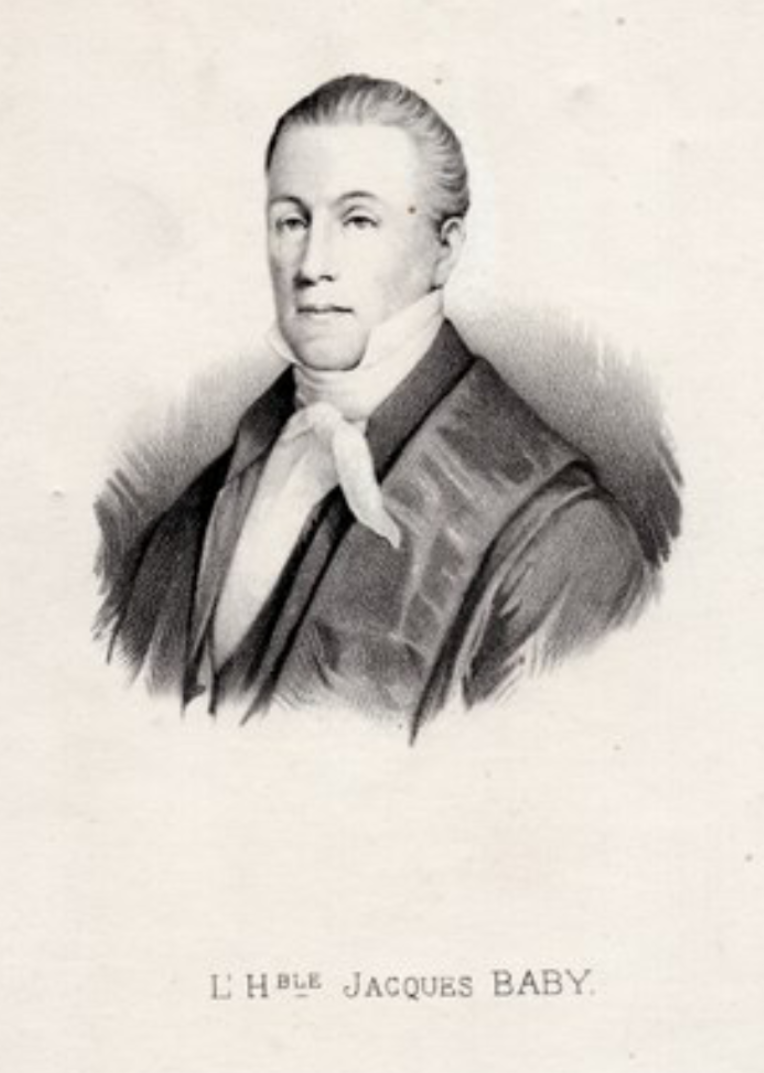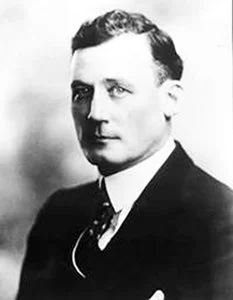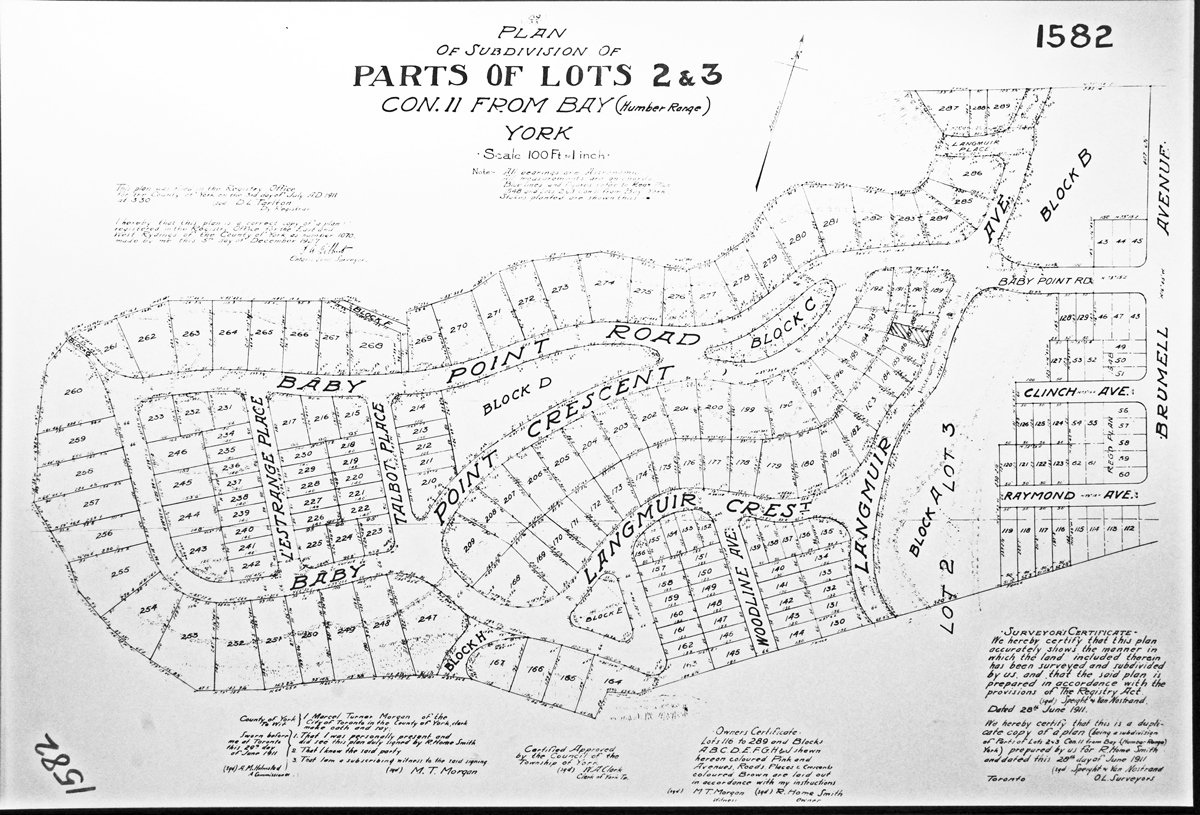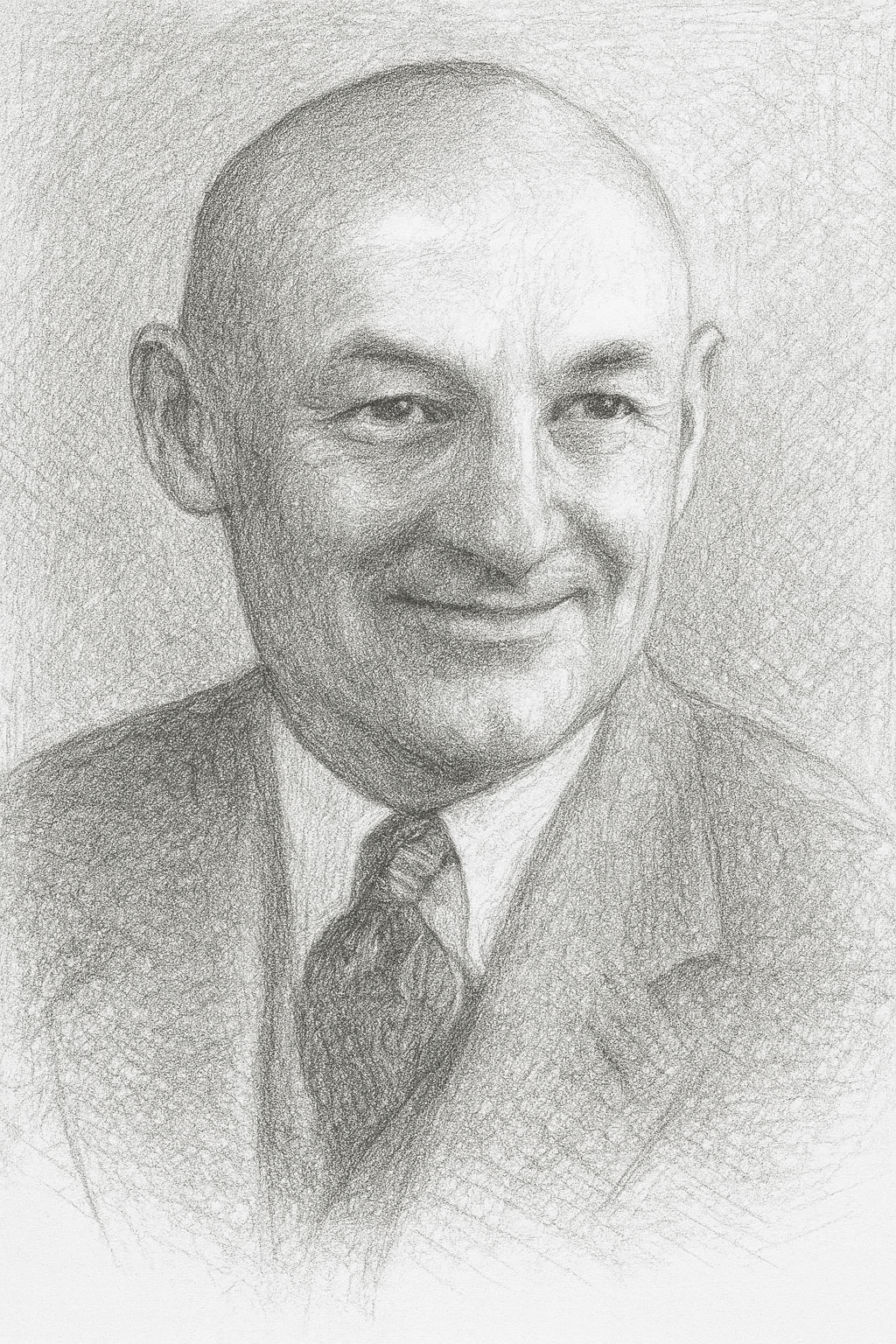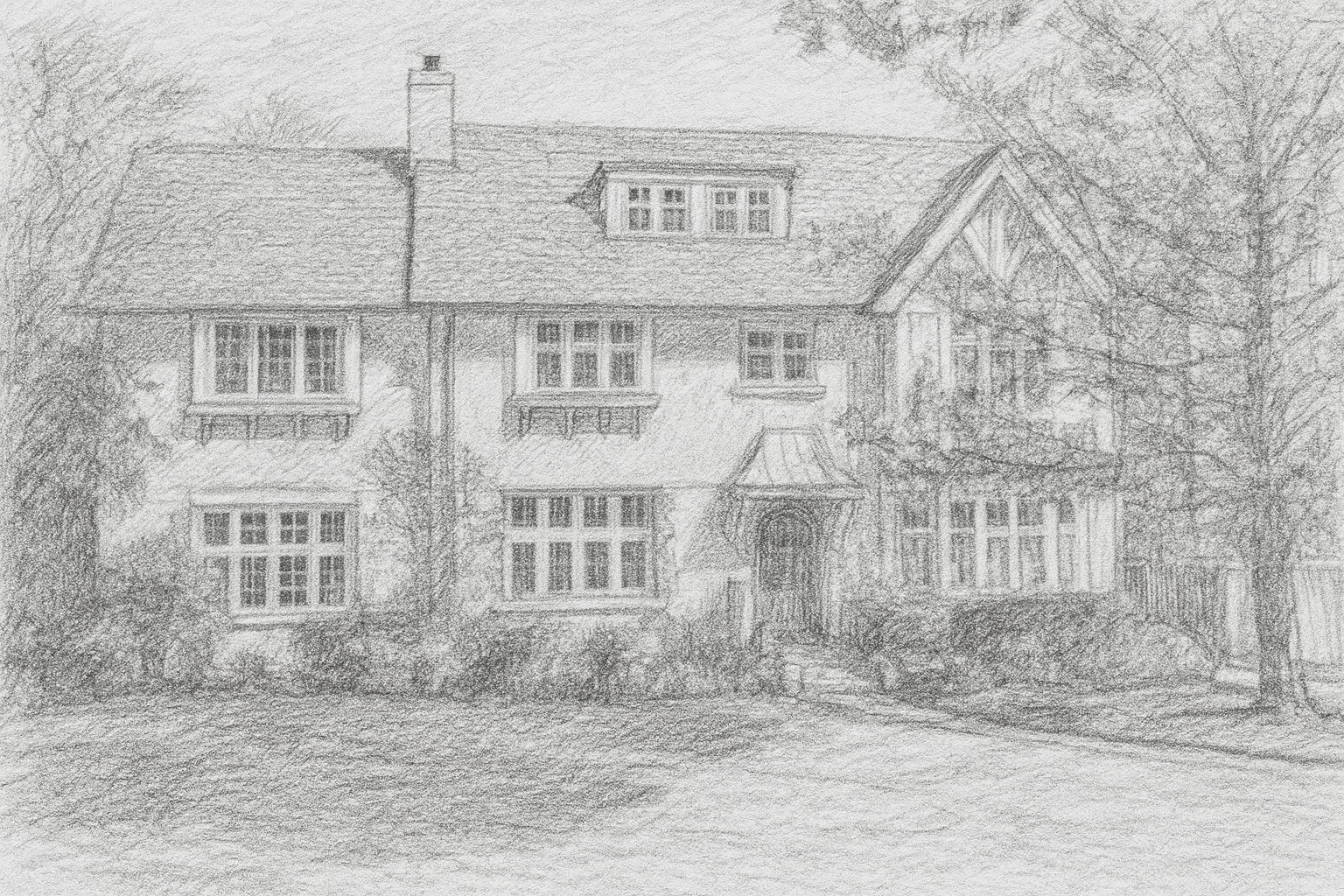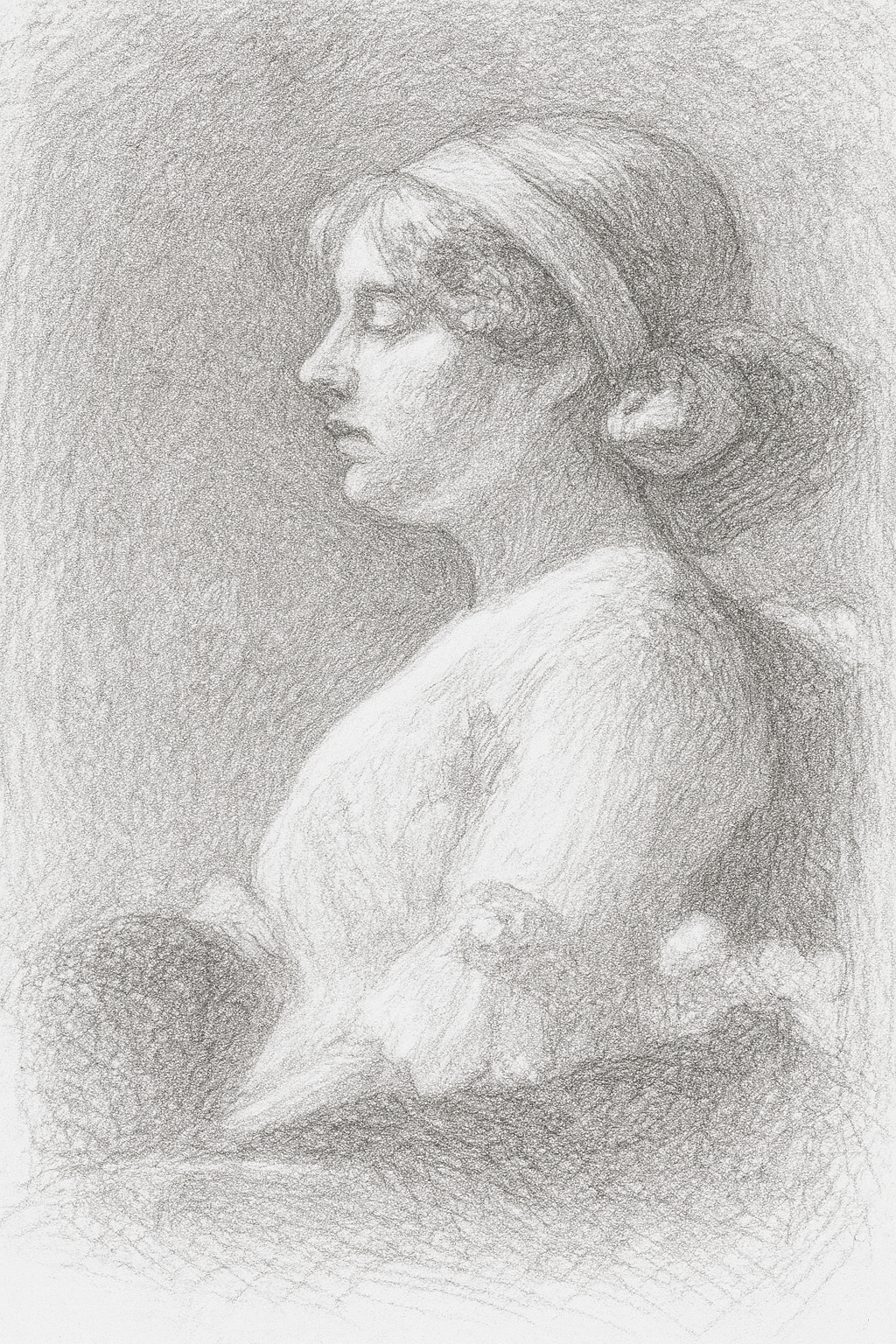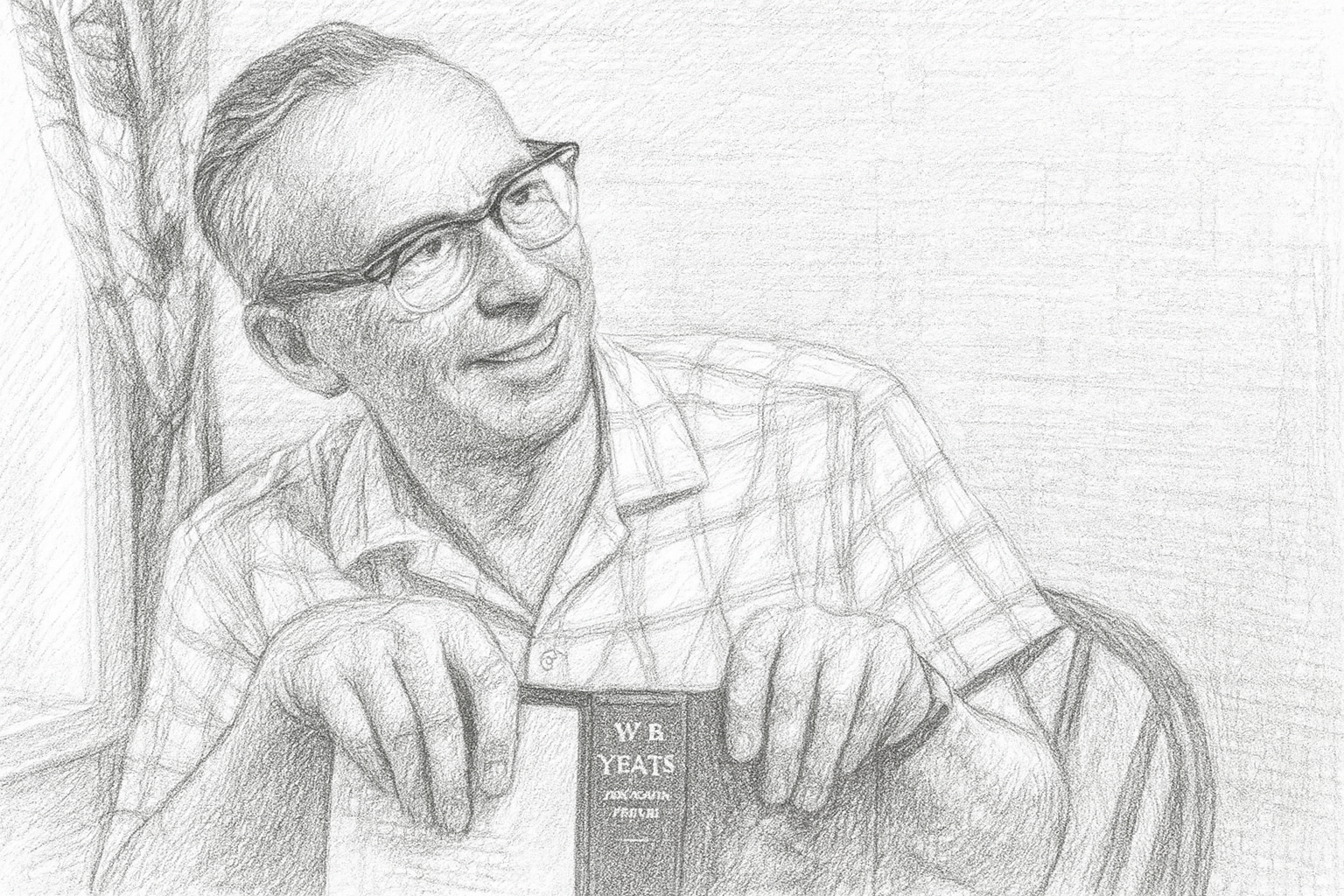Historical Timeline
First Nations 1600-1687 (Teiaiagon)
THE ORIGINAL INHABITANTS: FIRST NATIONS PEOPLES
Teiaiagon: The neck of the peninsula of Baby Point is traversed by an ancient Aboriginal trail, which dates back more than 4000 years and is the traditional territory of many First Nations, including the Mississaugas of the Credit, the Anishnabeg, the Chippewa, the Haudenosaunee and the Wendat peoples and is now home to many diverse First Nations, Inuit and Métis peoples. There are 3.67 Carrying Place Map large Paleolithic camp sites all along the trail, one of which is just north of Baby Point on Langmuir (now Humbercrest Blvd), stretching north to St. Mark’s Road. This ancient lakeshore trail would have come north to the break in the ravine and a fording location at what is now the Old Mill Bridge crossing. The Baby Point height of land, which overlooked this important crossing – intersecting with what became the Carrying Place Pathway— commanded sight lines of both routes, and was a natural fortification site. The Seneca village of Teiaiagon was strategically located at this site, the limits of navigable water when paddling north from the mouth of the Humber River.
Sometime after 1687, the Senecas disappeared from the Point, returning to the south shore of Lake Ontario. There are differing points of view as to why this happened: first, the French, heavily invested in the fur trade, burned Teiaiagon in 1687 to punish the Senecas for trading with the English and Dutch to the south; second, it was related to a threat or attack by Governor Denonville (who weathered out a storm by anchoring in the Humber Marshes in 1687 while returning from an attack on the Iroquois in Niagara); or, that the land was becoming depleted for agricultural purposes.
By 1700, the Mississauga First Nation (Ojibway in origin) controlled the Baby Point area, hunting and trading here. Now known as the Mississaugas of the New Credit, they were the First Nation of the Toronto Purchase of 1787 and 1805. Toronto is covered by Treaty 13, signed with the Mississaugas of the Credit, and the Williams Treaties, signed with multiple Mississaugas and Chippewa bands. The related land claims were settled at the end of May 2010 by Treaty 13.
This historic plaque, mounted on a large granite boulder found at the corner of Baby Point Road and Baby Point Crescent, marks the Teiaiagon site.
The plaque reads: “This area includes the site of Teiaiagon Iroquois Village at the foot of the Toronto Carrying Place (Le Portage de Toronto). This way passed Étienne Brûlé, the first non-Indigenous person to see Lake Ontario, 1615; René Robert Cavelier de la Salle, explorer of the Mississippi, 1680 and 1681; and John Graves Simcoe, first Lieutenant Governor of Upper Canada, 1793. These lands, now known as Baby Point, were purchased by Honourable James Baby, member of the Legislative and Executive Councils, in 1820.”
(Image: Teieiagon Plaque)
ARCHAEOLOGICAL SIGNIFICANCE
Baby Point in its entirety has been designated an Ontario Archaeological Site of Provincial Significance. Archaeologist A. F. Hunter first discovered traces of a palisade in 1889, thought to be either from Teiaiagon or from the French fort built for trading in 1720, according to historian Percy Robinson. The find was made on the site of the Baby Point Club. In 2010/11, during an extensive renovation being carried out on a Baby Point Crescent home, an intact First Nations burial site was discovered.
(Image: Map of the Toronto Carrying Place)
Dated from the 1660s by archaeological experts, the burial place of a Seneca woman included not only skeletal remains, but also a hair comb (image shown to the left) carved from moose antler and a copper pot. The comb was placed in the care of the Toronto Museum Project, duplicated, and then ceremonially reburied, as were the remains. In the past, residents of Baby Point have found arrowheads while gardening. A small collection of these can be found in the Baby Point Club. The north ravine bordering what is now the Magwood Sanctuary is the site of the Thunderbird burial mound, a sacred place for First Nations peoples. See more here: https://www.toronto.ca/wp-content/uploads/2018/05/987d-Baby-Point-HCD-Study_CCM2_Historical-Timeline-Display-Boards.pdf
Fur Traders and Coureurs de Bois 1615-1767 (Le Magasin Royal)
(Image: Illustration of trade between the French and First Nations by Charles. W. Jefferys, 1942)
(Image: Probable location of Le Magasin Royal, Illustration by Charles W. Jefferys, 1942)
FRENCH VOYAGEURS AND THE FUR TRADE
In September 1615, explorer Étienne Brûlé, travelling with a group of Huron/Wendat allies, followed the Carrying Place Trail/Pathway** south from Lake Simcoe to Lake Ontario, making Brûlé likely the first white man to reach Lake Ontario. Brûlé was on a mission for Samuel de Champlain to find more First Nations allies in their quest to control the lucrative fur trade and meet Europe’s enormous demand for (mostly) beaver pelts. Felt hats made of beaver pelts had become highly fashionable in Europe. When a group of English merchants aiming to gain control of the fur trade sent a flotilla to New France (including modern-day Ontario), Brûlé deserted Champlain to join the English, who soundly defeated Champlain in 1629. After Champlain’s death in 1633, Brûlé returned to the Huron, who now considered him a traitor. The Huron burned him at the stake, dismembered him and ate his heart. The Iroquois, who were allies of the English and also vying to control the fur trade, began destroying Huron and Algonquin settlements on the north shore of Lake Ontario. At this time, Teiaiagon was ransacked and the Huron, who fled to the south shores of Lake Ontario, abandoned the village, leaving it for the Iroquois. In 1687, a French-led army attacked their long-time adversaries, the Iroquois, burning Teiaiagon to the ground and killing its inhabitants. The series of conflicts over the fur trade is now known as the Beaver Wars (or Iroquois Wars or French and Iroquois Wars). The land comprising modern-day Baby Point was ceded to the Mississauga, who occupied a village on the west bank of the Humber River.
LE MAGASIN ROYAL
The Douville brothers started trading at the Humber River mouth in 1716. Under the orders of Governor Denonville, Douville built the fort known as Le Magasin Royal in 1720 at the site of modern-day Baby Point. Le Magasin Royal and Fort Rouillé (where Exhibition Park now stands) were the first two European establishments in what is now Toronto. The probable location of Le Magasin Royal is where the tennis courts and Baby Point Club stand today. In exchange for fur pelts, Douville’s list of traded goods includes buttons, shirts, ribbons, combs, knives, looking glasses, axes, flour, lard, salt, pepper, prunes, raisins, olive oil, tobacco, vermillion, powder and shot. Le Magasin Royal was abandoned in 1730 as new establishments were built to the south of the site.
The Carrying Place Trail/Pathway was a long portage along the eastern shore of the Humber River. The route terminated when reaching navigable water at some unknown spot on the Holland River near Holland Marsh. It was a route to Lake Simcoe and the fur-rich lands to the north and west. This route was used not only by First Nations, but also by the coureurs de bois. It was integral to the trade for beaver pelts in Canada, feeding the seemingly insatiable European market for fur.
Pioneers and Settlers 1783-1910 (James Baby)
THE TORONTO PURCHASE
The lands comprising modern-day Baby Point were purchased from the Mississauga First Nations as part of the Toronto Purchase in 1787. Following the Treaty of Paris in 1763, which marked the end of the Seven Years’ War between France and Great Britain, and the fall of New France, the territory comprising modern-day Ontario was ceded from the French to the British (renamed British North America and later Upper Canada). The area was sparsely populated, with the largest settlement being Detroit, which had been founded by the French. In the years after the Americans defeated the British during the American Revolutionary War in 1783 (capped by another Treaty of Paris), about 10,000 Loyalists fled to Upper Canada, where they began to settle on land recognized by the British Crown as ‘Indian Land’. The settlers’ lack of legitimate land created challenges for Lord Dorcester, who arrived in Quebec in 1786 just as British North America was being split into Upper and Lower Canada. John Graves Simcoe was appointed the first Lieutenant-Governor of Upper Canada in 1791. After deciding on the Bay of Toronto as the site of the new province’s capital, Lord Dorcester arranged to purchase much of the land comprising modern-day Toronto, including modern-day Baby Point, from the Mississauga. In 2010, the Government of Canada agreed to a $145 million dollar settlement resulting from a land claim initiated by the Mississauga in 1986, disputing the terms of the purchase.
LAND PETITIONS AND UNITED EMPIRE LOYALISTS
As a flood of refugees migrated north after being driven from their homes in America following the American Revolutionary War, the Government of Upper Canada began granting land to Loyalists who fought on the side of the British or simply pledged their loyalty to King George III. Loyalists were conferred the title of United Empire Loyalist (UE) and their children were conferred the title of Sons of Empire Loyalist (SUE) or Daughters of Empire Loyalist (DUE). One such Loyalist was John Lawrence. Lawrence had been imprisoned during the American Revolution as a traitor. His cellmate was none other than John Graves Simcoe, captured during the war. The two became friends and Simcoe approved Lawrence’s petition for a land grant in 1797. Lawrence’s land grant included the property from the modern day Old Mill to Dundas street. It came with the obligation to construct a grist mill on an island on the Humber River. Lawrence died the following year in 1798 just as the new settlement began to gain economic importance. It remains unclear if the grist mill was ever built.
(Image: Plaque about the Toronto Carrying Place/Le Portage de Toronto)
(Image: Portrait of Jacques (James) Baby)
(Image: Appointment of James Baby to the Legislative Council for Upper Canada,1792. From the Jacques Duperon Baby family fonds, F 2128, MU 18, Archives of Ontario. Reproduced by permission)
JAMES BABY ACQUIRED THE LANDS COMPRISING MODERN-DAY BABY POINT
In 1820, (James) Baby purchased 114 acres of land (part of Lots 2 and 3 on the Humber, 2nd Concession from the Lake) that comprised what later became known as Baby Point. Born in Detroit in 1763 (at the time under the British), Baby’s ancestors had emigrated to Quebec from France as settlers and fur traders in the mid-17th century. The land he purchased had changed hands several times after the initial short-lived grant to the Loyalist, John Lawrence. Baby purchased it after he was appointed Inspector General of Upper Canada in 1815 and moved to York (later Toronto) to take up his appointment. He never lived on the property, preferring to reside in downtown York on Market Street (today Wellington St., between Church and Peter Sts.), but he frequently visited it for recreational purposes, especially to fish with his sons in the Humber River.
James Baby held many important government appointments; among others, he was a member of the Legislative and Executive Councils of Upper Canada, a member of the Land Committee, deputy General Superintendent of the Bureau of Indian Affairs, and a member of the Commission to determine the boundaries of Upper and Lower Canada. He belonged to the so-called Family Compact, an ultra-conservative clique of British colonial administrators who ran Upper Canada. As a native-born French-Canadian, Baby was an anomaly in the group. Nevertheless, he was staunchly loyal to the British for 40 years, anglicized his name to James, and voted with the group to oppose progressive legislation, such as the Act Against Slavery put forward by John Graves Simcoe in 1793. The opposition resulted in a gradual phase-out until its complete abolition across the British Empire in 1833, rather than an immediate end to slavery. Baby himself owned a black slave named Thérèse, whom he had purchased from his brother, who had inherited her from their father, Jacques Dupéron Bâby (d. 1789). She was emancipated in 1803, and lived with Baby, a widower, in his house in York until her death in 1826. Baby himself died in 1833 and was survived by his daughter and 5 sons. His wife, Elizabeth Abbott, had died tragically during the War of 1812 in Sandwich (Windsor), where the Baby family had been forced to relocate after the Americans took Detroit and where the Baby family mansion is a historical landmark today.
MILLS OF THE HUMBER RIVER
The area surrounding the Humber River began to flourish in the 1800s as local economies grew around the mills. The first King’s Mill (built 1793 at the site known today as the Old Mill) burned to the ground in 1803. The last and grandest King’s Mill (same site as the first mill) was built in 1848, but also burned in 1881. At its peak in the 1840s, the surrounding village of Milton Mills was home to about 100 people. The remains of the grist mill for grinding grain could be seen until 2000, when they were dismantled and replaced with the current hotel, whose foundations were modelled after the mill and even used some of the original stones.
Cooper’s Mill was built in 1807 at the end of Old Dundas Rd. and today is the site of an apartment building across from Lambton House, an inn established in 1848 and used until 1988. William Howland bought the mill in 1851 and changed the name of the mill and village (pop. ~500) to Lambton in honour of John Lambton, a former Governor General of Canada. Howland himself was elected to the provincial Legislature in 1858 and later became a Father of Confederation and the second Lieutenant-Governor of Ontario. Old Dundas Rd. continued across a bridge spanning the Humber River, and the inn was used by weary travellers on their way to faraway places like London and Hamilton.
THE BENT RAILWAY
The ill-fated Bent Railway line was built in 1891, but it was an economic disaster that lasted less than two years. The tracks on the Humber loop passed almost directly where the Baby Point roundabout at the intersection of Humbercrest and Baby Point Rd. sits today. The track continued just to the east of Humbercrest to the north of Baby Point Rd. The closest station was to the west of the intersection of Jane and St. Clair Streets. Another part of that line passed through the Junction neighbourhood. When the tracks were removed in 1983, a new neighbourhood was constructed surrounding the Baby estate to the north, south and east.
20th Century Development 1910-2000 (Robert Home Smith)
(Image: Photo of Robert Home Smith)
(Image: Front Cover of the Humber Valley Surveys booklet)
HOW IT BECAME BABY POINT
Heirs of the Baby family stayed in the area through the remainder of the nineteenth century. Raymond Baby’s home was located on the north side of what is now Langmuir Crescent near Orchard Crest (the plateau became his orchard). Raymond Avenue was the lane that led to his home. In about 1880, the family moved into a new home at 173 Jane Street (between Hanely and Montye). That home was demolished in the 1950s (about that time, Mrs. Baby, an elderly lady with flaming red hair, recollected that Annette Street had been named for one of the women of the family, and Jane Street for her best friend. That way, the two friends would always ‘meet’.
By 1901, the surviving grandsons of the Hon. James Baby had effectively lost control of the property. A complicated title situation was resolved when the Federal Government purchased the property in 1909, intending to use it as a new Garrison common to replace the one adjacent to old Fort York, but quickly realized there was insufficient distance from a residential area for rifle ranges. After purchasing an alternate site, the land was sold to developer Robert Home Smith. Home Smith submitted a Plan of Subdivision to the City of Toronto in April 1911, retaining the name of the man who first purchased the land: Baby Point.
In 1911/12, Robert Home Smith submitted plans to the City of Toronto detailing development on both banks of the Humber River, after amassing large tracts of land for the purpose. Collectively known as the Humber Valley Surveys, the plans called for large, luxurious homes on tree-lined streets. For Toronto, a city accustomed in 1911 to expansion of unplanned, ramshackle suburbs, Home Smith “undertook one of the most ambitious, exclusive residential housing schemes ever devised in North America.” Baby Point’s boreal oak forest was to be protected and preserved, and hardscaping and landscaping executed to create a neighbourhood which represented the best principles of the Garden City Movement. Home Smith imposed building restrictions – laid out in a Covenant found in the Humber Valley Surveys — that were visionary in the field of urban planning, allowing only defined building coverage and setbacks. His lot sales included restrictive covenants on the land, which remained in place for 30 years, ensuring the stability of the neighbourhood, a factor which was important to his purchasers. He insisted on following existing topography and protecting natural landscaping features, critical for the plateau, ravines and the old oak savannah found on Baby Point.
The north Ravine of the Point was a remnant of an Old-Growth Forest and a rare Woodland Marsh, and was later designated as the Magwood Sanctuary by York Township to protect the natural landscape. As a consequence, Home Smith was very specific about the footprint location — the siting — of every house and outbuilding. He was exquisitely aware of the Point’s history and its importance in Canada’s history, and was determined to preserve that legacy.
DID HOME SMITH SUCCEED?
“If I had to name the most unaffectedly gracious and artistically planned subdivision in Toronto, the winner would surely be – not the Annex, not Moore Park, certainly not Forest Hill – but Baby Point. As far as I can tell, developer Robert Home Smith got everything right when he laid out the new neighbourhood’s streets, parklands and ample building lots in 1912. Edwardian and later architects and builders then filled in the blanks that Home Smith had inscribed on the plateau above the Humber River. The result of these efforts is a set of beautifully well-ordered streetscapes with broad lawns and spacious family dwellings. By and large, the public faces of these detached houses convey solidity, rootedness, propriety, and other cultural values cherished by our Edwardian ancestors. And they weren’t the only people who had done so. Numerous house-hunters nowadays want to see these old-fashioned ideals embodied in the buildings they live in, and about a thousand current home-owners and their families have discovered such architectural traditionalism on the pleasant, shady streets of Baby Point ”.
- John Bentley Mays. The Globe and Mail (8 June 2012)
Modern-Day Baby Point: The 2000’s
(Image: The Baby Point Clubhouse, photograph courtesy of David Slaughter)
MODERN DAY BABY POINT
In his plan for the Baby Point neighbourhood, developer Robert Home Smith was committed to providing land reserves for churches, recreational purposes, schools and commercial uses, including a farmer’s market. Land reserved by Home Smith allowed creation of the Baby Point Club in 1923 by residents of the growing neighbourhood. The Baby Point Club has helped to maintain a small community atmosphere for more than 90 years and has been the social and recreational nucleus of Baby Point with tennis courts, a lawn bowling green, a skating rink and a clubhouse which has been expanded and renovated since its original build. The Baby Point Club property was bought for $5,000 by local residents, with letters of patent issued November 30, 1923. The owners, together with other interested persons, established an organization called the Baby Point Club Ltd. Today the club is one of two community clubs in Toronto which own their own property and pay property taxes rather than rent for city property. This approach to developing the community paid off in a community fitting Home Smith’s vision.
Planning the Point
ROBERT HOME SMITH’S PLAN FOR BABY POINT
Clients could use architects of their choice to create plans for their residences, but the plans had to be submitted and approved by the Home Smith team. Siting was important and unalterable. At one point, he employed an architectural staff of almost 30 people vetting plans, materials, designs, uses and building quality, to ensure compliance with the requirements of the buyer’s covenant.
(Image: A rendering executed in 1912 (artist unknown) for houses to be constructed 1913 on Baby Point Road, from the Home Smith and Company Humber Valley Surveys)
(Image: A photograph taken in 1912 of the newly built Baby Point Gates, City of Toronto Archives)
(Image: The Home Smith and Company Humber Valley Surveys)
ROBERT HOME SMITH’S BUILDING RESTRICTIONS COVENANT
The following is a copy of the building restrictions in the form of a Sale Agreement, which shall run with the land and be in force for a period of thirty years from the first of April 1911:
I. No attached or semi-detached house shall be permitted, and one detached dwelling house and no more with or without suitable coach houses, out-houses and stabling of the prime cost (exclusive of the cost of any such coach houses, out-houses or stabling) of not less than ____ dollars may be erected and standing at any one time on any lot on said plan.
II. The external walls of each of said dwelling houses shall be constructed of stone, brick, cement, and such building shall be designed by some architect of good standing, and the plans of such buildings shall be approved by the Vendor’s architect, and all buildings are to be placed on the lands in positions to be approved by the Vendor.
III. In case it is desired to construct such external walls of any other material than stone, brick or cement, then the same shall only be done after first obtaining the written consent of the Vendor, and such dwelling house shall in that case be constructed in conformity in every respect with the plans, elevations, sections and specifications to be first approved of and signed by the Vendor, under the inspection and to the satisfaction of the Vendor or the architect for the time being of the Vendor and at the cost and charges of the applicant.
IV. No such building or the land appurtenant thereto shall be used during such period for purpose of any profession (save of a duly qualified doctor or dentist), business, trade, sport or employment or for any purpose which might be deemed a nuisance, but may be only used for residential purposes, but such residential purposes shall not include an apartment house or houses.
V. No excavations shall be made on any of the said lots except for building on said lot, and at the time when the person holding said lot is commencing such building operations, and no sand or earth shall be removed from any of the said lots except as part of such excavations.
VI. No part of any such dwelling house, or its verandah, porch or steps shall be nearer to the street line than ____ feet. Without the vendor’s consent no front or boundary fence shall be erected within ____ feet of the street line unless the same is of open construction and not higher than ____ inches, and no other line fence or obstruction shall be higher than ____ feet, and the style and character of all fences shall be subject to the approval of the Vendor.
VII. On any of the bank lots as shown on said plan, no trees situated between the summit and bottom of said bank shall be cut down or removed without obtaining the consent of the Vendor thereto in writing.
VIII. No signs, billboards or advertising matter of any kind shall be placed upon said property without the consent of the Vendor in writing.
IX. The Vendor, his heirs, executors, administrators or the assignee from him of the Agreement may agree to vary or cancel any of the above conditions or substitute other conditions in respect of this or any other Lot on said Plan.
X. The covenants in respect to the above restrictions shall extend and bind and may be taken advantage of by the respective heirs, executors, administrators, successors and assigns of parties hereto.
From the Humber Valley Surveys, 1912 (reprinted in 1999 by The Swansea Histoical Society)
Notable Residents
RAYMOND SOUSTER (1921-2012)
CONN SMYTHE (1895-1980)
NHL Hockey Legend, The Toronto Maple Leafs, Maple Leaf Gardens, The Hockey Hall of Fame, The Conn Smythe Trophy. 68 Baby Point Road was the home of Constantine Falkland Carry Smythe (“Conn”) and his family. The Smythes were the first owners of the house, moving in 1927. During an interview in 2011 on the Rogers TV Series Structures featuring Baby Point, Dr.Hugh Smythe, son of Conn Smythe, states that Conn Smythe bought into the neighbourhood because “he was a good friend of Robert Home Smith”. Conn Smythe died at his home on 68 Baby Point Road at age 85 in 1980. He is buried in the nearby Park Lawn Cemetery. Conn Smythe is best known as the owner of the Toronto Maple Leafs. As well, the prestigious National Hockey League MVP award, the Conn Smythe Trophy, was introduced in 1964 to honour Conn Smythe. He had been the manager of the New York Rangers, but “after a falling out with management”, he and several associates bought the team in 1927, changing its name from the “Toronto St. Pats”. Subsequently, Maple Leaf Gardens was built largely owing to his efforts. Smythe served as Managing Director and President of Maple Leaf Gardens until 1961. During that time, the Maple Leafs won five Stanley Cups.
In addition to his role with the Maple Leafs, however, Smythe was also notable for serving in both World Wars, winning the Military Cross twice in the First World War, and organizing his own artillery battery in the Second World War, where he was seriously injured. He was also a racehorse owner, winning the Queen’s Plate twice. In addition, he supported a number of charities and founded the Conn Smythe Foundation as a focus for his philanthropic endeavours . Other connections with the west end of the City include Smythe Park and Recreation Centre, located between Scarlett Road and Jane Street north of St. Clair Avenue. This is located on the site of a gravel pit, which he owned and operated. The surrounding neighbourhood is known as Rockcliffe-Smythe and includes a subdivision he built for war veterans.
The Conn Smythe House, 68 Baby Point Road, built in 1927, was designed by Toronto architect George Roper Gouinlock. On March 27, 2018, the Council of the City of Toronto passed By-law 270-2018 to designate the property of 68 Baby Point Road (Conn Smythe House) as being of cultural heritage value of interest. Etobicoke York Community Council voted unanimously in favour of protecting the home with a heritage designation in 2016.
CLARA ISABELLA HARRIS (1887-1975)
23 Valleyview Gardens was home to impressionist artist Clara Harris. Clara Isabella Harris (nee Perry) was born in King City, Ontario, on October 13, 1887. She attended the Ontario College of Art (OCA), where she studied under John W. Beatty, an associate and influential to the Group of Seven painters, as well as noted portrait painter Archibald Barnes. She attended the Port Hope Summer School founded by John William Beatty, and was a student of George Agnew Reid, Manly MacDonald and William Cruikshank.
Harris is remarkable for her careful documentation of many of her paintings, including where and when the paintings were done, sometimes even the time of day. Many of these paintings are depictions of Southern Ontario that no longer exist, especially those of Toronto that have long since been paved over and developed. This historical record exists nowhere else. She also painted parts of the Canadian Maritimes and of boats and harbours in the U.S. Northeast. As she painted very few portraits, the ones on this website are a wonderful addition to this collection. During the First World War, Clara studied at the Art Institute of Chicago. She exhibited at various art shows, including The Sixty-First Annual Exhibition of the Ontario Society of Artists, March 1933; The Artists’ Annual Non-Jury Exhibition, Canadian National Exhibition Art Gallery, May 1-15, 1935; The 71st Annual Spring Exhibition, Ontario Society of Artists, The Art Gallery of Toronto, March 5-29,1943.
She exhibited her work at various art shows alongside but not limited to Arthur Lismer, A.J. Casson, A.Y. Jackson, Clarence Gagnon, Frank Panabaker, Homer Watson, Lawren Harris and Emily Carr. Her work was also exhibited at the Kaspar Gallery, October 1987 alongside that of Emily Carr, Paraskeva Clark, Kathleen Daly, Dorothy Knowles, Kathleen Morris, Mary H. Reid and Anne Savage. Clara married Frederick W. Harris, a draughtsman and artist. They lived for many years in the west end of Toronto at 23 Valleyview Gardens in the Baby Point neighbourhood. They shared their love of art as they travelled through Ontario, the Maritimes and New England. Their sketches, paintings, linocuts, greeting cards and correspondence are a tribute to this. True to the Group of Seven’s “plein-air” method of sketching and painting Clara travelled and painted on location capturing the beauty of each season. She was a stickler for authenticity never painting from post cards or slides.
DANTE MATTHEW De MONTE Q.C., L.L.B. – (1926-2009)
Dante De Monte lived at 98 Baby Point Road. He was born in Toronto on May 6, 1926, on Symington Avenue. After serving in the Royal Canadian Navy during the Second World War, he obtained his B.A. at St. Michael’s College, University of Toronto. Dante graduated from Osgoode Law School in 1955, and he practised law in Toronto for 40 years. He was active in Liberal politics, serving as Vice-President of the Toronto and District Liberal Association from 1963 to 1967. In 1967, he was elected Member of Provincial Parliament for the riding of Dovercourt — the first member of the Ontario legislature of Italian descent. His special interests were immigration, citizenship and labour, and he was named labour critic for the Opposition. His support and advocacy of the Italian community in Toronto included service as Executive Vice-President of the Italian Immigrant Aid Society, and he was active in Famèe Furlane Society, which was formed to assist immigrants from the Friuli, from whence his parents had immigrated. He participated in the founding of the Famèe Furlane Club, now part of the Friuli Centre in Toronto’s west end. A consummate organizer and fundraiser, Dante served as President of the Michael Power/ St. Joseph’s Dad’s Club for eight years and successfully raised large funds for the school community, for which he was presented with a special award of appreciation from the Sisters of St. Joseph and Basilian Fathers in 1986.
His organizing skills carried over into neighbourhood life, and he helped organize the annual Games Days for the Baby Point Club, especially in the barbecue department. His roast pigs and half steers soon became part of local lore. Dante was the refined and enthusiastic host, convivial raconteur and lover of the family barbecue, the latter often including many neighbourhood kids. He adored his seven children, and the memorable image of the De Monte brood piling in and out of Dante’s stylish 1966 Mustang has survived the test of time. He was a devoted husband and tirelessly supported his beloved wife Elvira, as advisor and campaign manager throughout her long and distinguished career as Separate School Board Trustee and Chairman. He was also a man of the arts, lover of the ballet, opera and symphony (to which he introduced his children), a voracious reader and amateur military historian and an excellent cook. This was balanced by his love of sport. Dante was a devoted fan of the Toronto Argonauts and held seasons tickets for decades, being a fixture at Argo games with his sons and nephews.
Raymond was a poet and lived at 39 Baby Point Road. Canadian poet and editor Raymond Holmes Souster was educated at the University of Toronto and Humberside Collegiate and served four years in the Royal Canadian Air Force. A lifelong resident of Toronto, he worked as a banker for nearly 50 years.
Souster’s free verse poems capture the details of daily city life. He was the author of more than 50 volumes of poetry, including The Colour of the Times: Collected Poems (1964), which won the Governor General’s Award; Hanging In (1979), which won the City of Toronto Book Award; and Take Me Out to the Ballgame (2002). His Collected Poems was published in ten volumes between 1980 and 2004. He also published under the pen names Raymond Holmes and John Holmes.
ENDEL TULVING
Canadian poet and editor Raymond Holmes Souster was educated at the University of Toronto and Humberside Collegiate and served four years in the Royal Canadian Air Force. A lifelong resident of Toronto, he worked as a banker for nearly 50 years. Souster’s free verse poems capture the details of daily city life. He was the author of more than 50 volumes of poetry, including The Colour of the Times: Collected Poems (1964), which won the Governor General’s Award; Hanging In (1979), which won the City of Toronto Book Award; and Take Me Out to the Ballgame (2002). His Collected Poems was published in ten volumes between 1980 and 2004. He also published under the pen names Raymond Holmes and John Holmes. A strong supporter of independent presses and experimental poetry, Souster was the founding editor for the literary journals Direction (1941–46), Contact (1952–54), and Combustion (1957–60) and the founding president of the League of Canadian Poets. His Contact Press first published, among others, Margaret Atwood and Michael Ondaatje. Souster also edited the anthologies Poets 56: ten younger English-Canadians (1956) and New Wave Canada: The New Explosion in Canadian Poetry (1966). His honours include the Centennial Medal, the Silver Jubilee Medal, and the President’s Medal at the University of Toronto, and he was named an Officer of the Order of Canada. Souster died of cancer at the age of 91.
After hearing news of Souster’s death, Margaret Atwood tweeted, “Goodbye to Raymond Souster, fine man and poet who helped run Contract Press. My first real publisher.” Michael Ondaatje, who had been another one of Souster’s young poets, wrote, “He brought many of us to the surface and we owe him everything.”
EUGENE NESTOR MELNYK (1959-2022)
Eugene Melnyk was a Ukrainian Canadian Entrepreneur and lived at 90 Baby Point Road. Eugene was born in Toronto and grew up in the Baby Point area of the city, where the Melnyk family lived until about 1978. The businessman, sports franchise owner and philanthropist was a passionate hockey fan. Melnyk was the owner, governor and chairman of the National Hockey League’s Ottawa Senators, the Belleville Senators of the American Hockey League and previously the Toronto St. Michael’s Majors of the Ontario Hockey League. He was the founder and former chairman of Biovail Corp., and in recent years invested his entrepreneurial skills in other companies. Melnyk was also a successful horse racing breeder, a member of the Canadian Horse Racing Hall of Fame and an Honorary Colonel of the Canadian Armed Forces. A generous philanthropist, he supported St. Joseph’s Health Centre, Help Us Help, CAN Fund, St. Michael’s College in Toronto (his alma mater), and Providence School in Barbados, where he was a full-time resident. Melnyk championed causes through the Ottawa Senators and Senators Foundation, an organization that invested more than $100 million to support local charities and community programs that help children and youth across Ottawa and Gatineau. He was the lead donor in the creation of Anna House, a childcare facility in Belmont, New York, and Roger Nielson House, a paediatric palliative care facility in Ottawa.
Psychologist and Neuroscientist, Professor-University of Toronto, Endel Tulving and his wife, Ruth, along with their two daughters, Elo Ann and Linda, lived on Baby Point Crescent and were members of the Baby Point Club for many years. Endel donated the Baby Point Tulving Trophy, which later became the trophy for the Men’s Doubles (1978-1990). Dr. Tulving was a member of seven distinguished societies and received a number of awards. In 2006, he was named an Officer of the Order of Canada, Canada’s highest civilian honour. Born in Estonia in 1927, in 1944, he was sent to live in Germany, where he finished high school and worked as a teacher and interpreter for the U.S. army. He briefly studied medicine at Heidelberg University before he immigrated to Canada in 1949.
Tulving attended the University of Toronto, where he earned both a bachelor’s and a master’s degree. In 1956, he completed his PhD in experimental psychology at Harvard University. That same year, Dr. Tulving accepted a lectureship at the University of Toronto, where he would remain for the rest of his career. He served as Chair of the Department of Psychology from 1974 to 1980 and became a professor in 1985. In 1992, he retired from full-time work at the University of Toronto and took a position at the Rotman Research Institute as the first Anne and Max Tanenbaum Chair in Cognitive Neuroscience until his retirement in 2010. By 2019, he held the titles of Professor Emeritus at the University of Toronto and Visiting Professor of Psychology at Washington University in St. Louis.
DR. ROBIN MCLEOD (FAUQUIER)
Robin McLeod, Surgeon and Professor Emeritus at the University of Toronto, and her husband, John Fauquier, were active members of the Baby Point Club when they resided on Baby Point Crescent. Dr. McLeod was at the forefront of training Canada’s future surgeons. She was a Professor at the University of Toronto and former president of the Canadian Association of General Surgeons, and she developed innovative guidelines for general surgery and designed educational tools to teach evidence-based practice. She was also the vice-president of Clinical Programs and Quality Initiatives at Cancer Care Ontario. At the helm of several important clinical trials, she had a profound influence on medical practice and knowledge translation in surgical education and care. Dr. McLeod was awarded the Order of Canada, Officer of the Order of Canada on November 22, 2019.
JAQUELINE BROOKS
Equestrian Jacqueline Books grew up on Baby Pont Road and attended Western University in London, ON. She is a Canadian dressage rider who competes in individual and team dressage. In 2003, she and her mount, Gran Gesto, won a silver medal at the Pan America Games in Santo Domingo, Dominican Republic. In addition to many international competitions, Jacqueline also represented Canada at both the 2008 Beijing and 2012 London Olympics.


